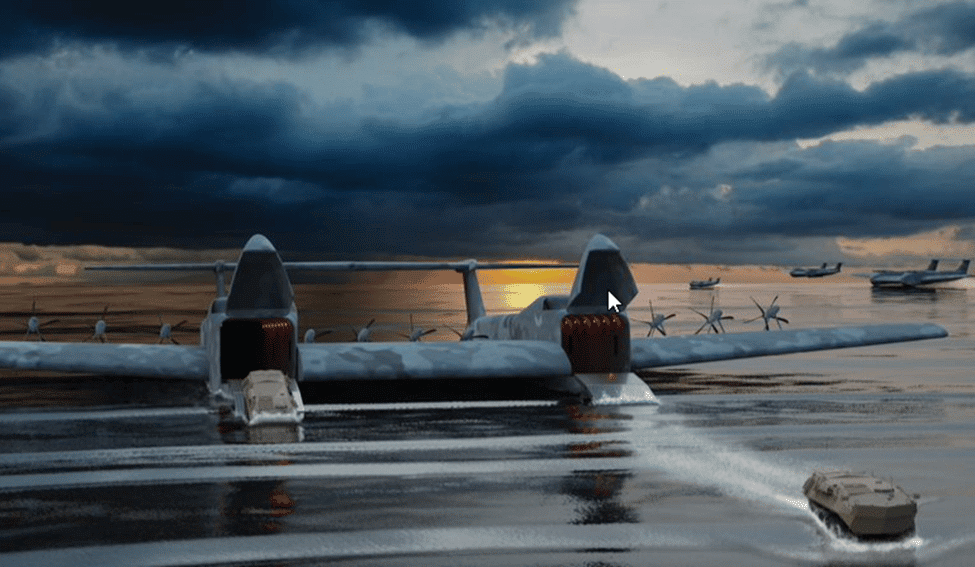Aviation
DARPA Selects Performer Teams for Liberty Lifter X-Plane Program

Darpa is involved in the development of a new form of seaplane that will have two cockpits and a huge span of wings and be able to transport significant quantities of supplies and personnel for a military base.
The concept video of the planning, which Darpa has produced, is a major development with numerous benefits for naval operations. The airplane will be propelled by a turboprop engine and will carry the cargo out of its nose door.
The planned Liberty Lifter demonstrator will be a large flying boat similar in size and capacity to the C-17 Globemaster III transport aircraft. Goals include takeoff and land in Sea State 4, sustained on-water operation up to Sea State 5, and extended flight close to the water in ground effect with the capability to fly out of ground effect at altitudes up to 10,000 feet above sea level.
Two teams — General Atomics working with Maritime Applied Physics Corporation and Aurora Flight Sciences working with Gibbs & Cox and ReconCraft — will develop designs for DARPA’s Liberty Lifter Seaplane Wing-in-Ground Effect full-scale demonstrator. The Liberty Lifter program aims to demonstrate a leap ahead in operational capability by designing, building, floating, and flying a long-range, low-cost X-Plane capable of a seaborne strategic and tactical heavy lift.
The General Atomics team has selected a twin-hull, mid-wing design to optimize on-water stability and seakeeping. It employs distributed propulsion using twelve turboshaft engines.
Aurora Flight Sciences’ point-of-departure design more closely resembles a traditional flying boat, with a single hull, high wing, and eight turboprops for primary propulsion.
During Phase 1, DARPA will work with both performer teams and Department of Defense stakeholders to refine the Liberty Lifter designs with particular attention to operational needs and operating concepts. The Phase 1 contract awards are for an 18-month period of performance with six months of conceptual design work and nine months of design maturation culminating in a preliminary design review. There will be an additional three months for manufacturing planning and test/demonstration planning reviews.
As scheduled, Phase 1 will transition into Phase 2 in mid-2024 with continued detailed design, manufacturing, and demonstration of a full-scale Liberty Lifter X-Plane. DARPA anticipates teaming with one or more DoD Service and international partners for those activities and further development of the Liberty Lifter concept into an operational vehicle.
Read More : click

Aviation
COMAC Unveils Plans for the C929 to Rival Airbus and Boeing

After the success of China’s first C919 aircraft, the country is setting its sights on developing a larger plane. COMAC (Commercial Aircraft Corporation of China) has officially confirmed plans to build a widebody aircraft, marking a significant step in its aircraft lineup.
Traditionally, Airbus and Boeing dominate the widebody aircraft market, with decades of expertise in developing planes and engines capable of carrying heavy payloads. China, which currently relies on imported engines, is now aiming to challenge these giants with its own widebody jet, the C929, designed to compete with the Airbus A350 and Boeing 777.
American Airlines Is Looking for Flight Attendants: Apply Now
The C929 will be China’s first independently developed long-range widebody aircraft. It adheres to international airworthiness standards and boasts independent intellectual property rights. The baseline version is designed to seat 280 passengers and offers a range of 12,000 kilometers, catering to global demand for both regional and international air travel.
Russia, which also needs reliable narrowbody and widebody aircraft, could become a key customer for the C929. Additionally, China plans to target the broader Asian market as it continues to expand its aviation capabilities.
Close Call at Heathrow: BA Flight Narrowly Escapes Drone Collision
China’s aviation progress includes the ARJ21 (now called C909), a regional jet with 100 seats for shorter routes, and the C919, a narrowbody jet with 180 seats designed to rival the Boeing 737 MAX and Airbus A320. Both models have found increasing demand in the domestic market.
At China’s largest air show in Zhuhai, COMAC announced that Air China will be the launch customer for the C929 widebody jet, though details about order size and delivery timelines were not disclosed.
Other major deals announced by COMAC include:
- Hainan Airlines: Firm orders for 60 C919 and 40 C909 regional jets.
- Colorful Guizhou Airlines: 30 C909 jets, with 20 firm orders and 10 provisional agreements.
The C929, renamed from the CR929 after Russia withdrew from the joint development project in 2023, is expected to carry 280–400 passengers with a range of 12,000 kilometers, competing directly with Boeing’s 787 Dreamliner.
According to COMAC’s deputy general manager, Tong Yu, the first fuselage section of the C929 is expected by September 2027, with prototype test flights anticipated soon after.
-

 Aviation2 months ago
Aviation2 months agoMicrosoft Flight Simulator Raises $3 Million to Bring Back the An-225 Mriya
-

 Airlines2 months ago
Airlines2 months agoQantas Engineers Stage Walkout Over Cost of Living Concerns
-

 Airlines2 months ago
Airlines2 months agoQatar Citizens Can Travel to the United States Without a Visa
-

 Aviation2 months ago
Aviation2 months agoQatar Airways bans these new Electronic Devices on plane
-

 Airlines2 months ago
Airlines2 months agoJapan Airlines Rolls Out Free Domestic Flights to International Passengers
-

 Defence2 months ago
Defence2 months agoWhich Country Has the Largest Fleet of Fighter Aircraft?
-

 Airport2 months ago
Airport2 months agoWestern Sydney Airport Welcomes Its First Plane After 6 Years of construction
-

 Aviation2 months ago
Aviation2 months agoDid you know ? Once Boeing 747 carried 1088 passenger in 1991








